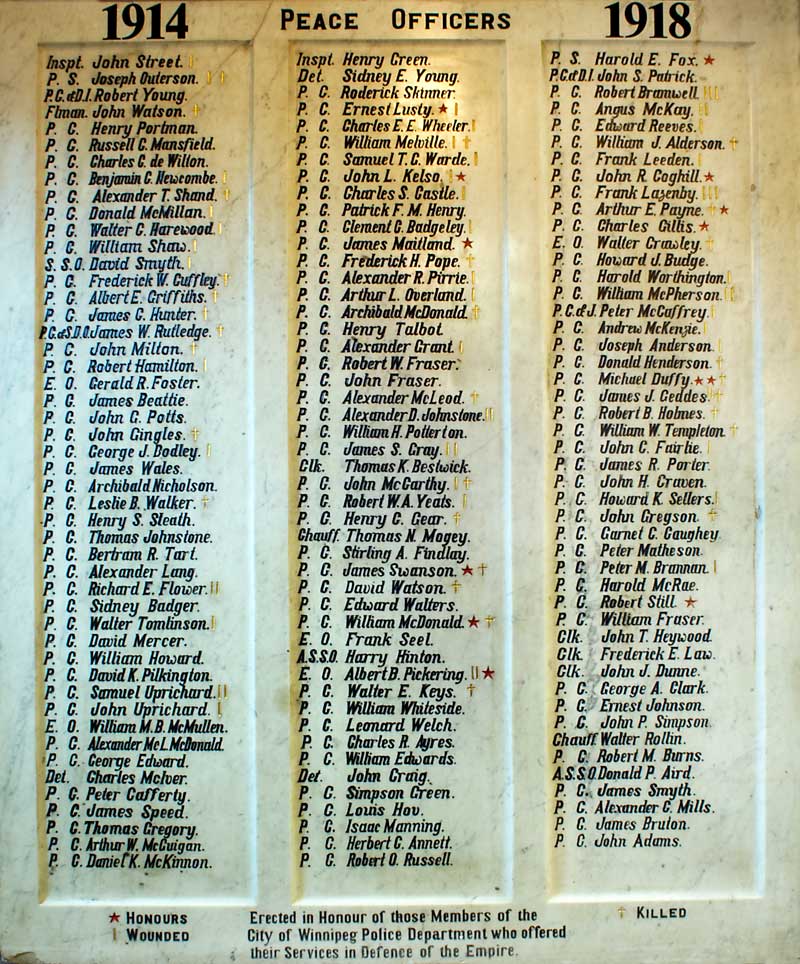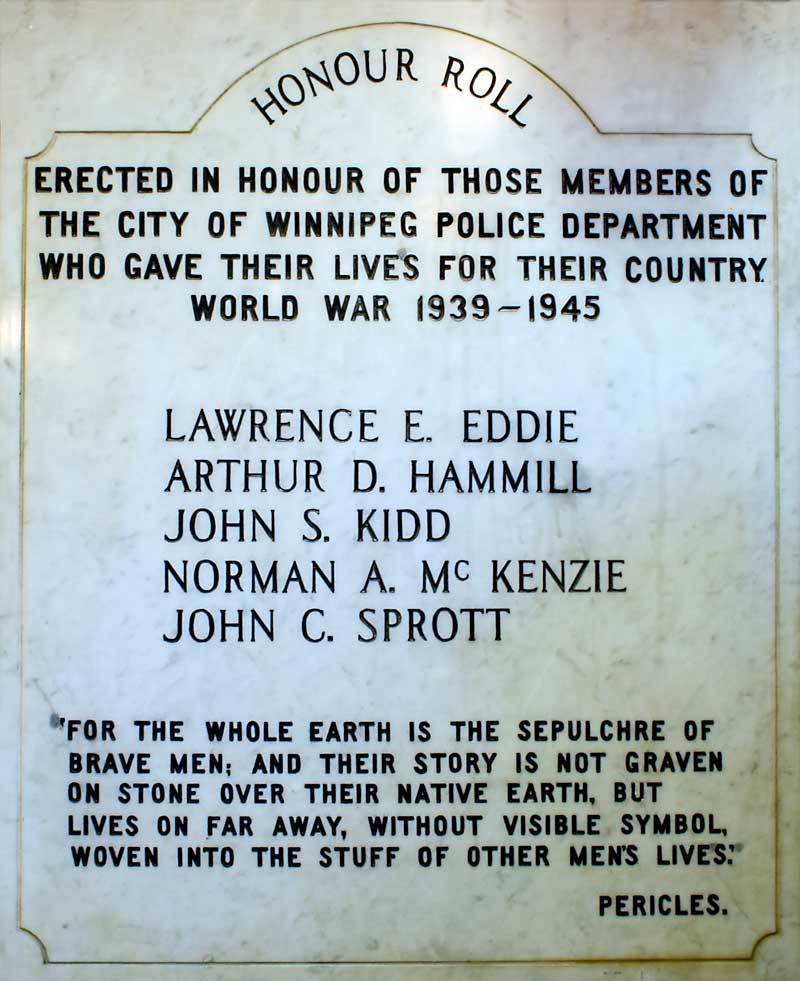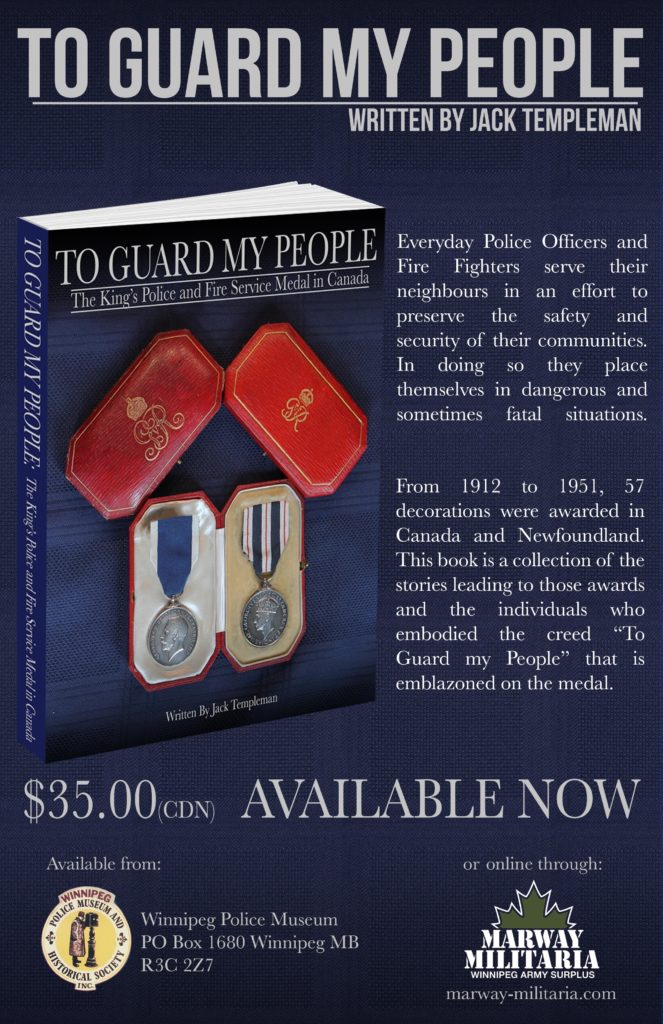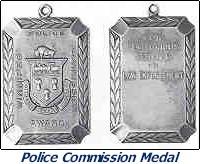military service & honors
Remembering members who served "King and Country"

On November 11, Canadians wear poppies and gather at war memorials across the nation to pay tribute to those who died in war. At the 11th hour of the 11th day of the 11th month, the time the Armistice of World War I was signed in 1918, we observe two minutes of silence to remember. While all members are undoubtedly aware of the significance of the WPS Colors, which commemorates our members who have fallen in the line of duty, many may not be aware of our own war memorials.
Housed with the lobby of Station Duty at Police Headquarters, two eloquent memorials adorn the walls paying tribute to those who served and those who fell while serving our country during the First and Second World Wars.
The larger memorial recognizes each WPS member who served in World War I and draws attention to those who were injured (some more than once), those who were killed and those recognized with military honors for their contributions.
In 1914 when World War I broke out, 152 of our officers were granted leave to join the King’s Forces in the trenches of Europe. This volume of men caused somewhat of a shortage in our ranks at the time, and the Service had to limit the number of leaves that were granted.
Twenty-nine of these members died in the line of duty and many more were injured along the way. Just 78 of the 152 members who went over to serve returned to their duties with the Police Department.
Among those to return was Cst. Charles Gilles MM. He returned from World War I with the Military Medal, earned “for bravery in the field”. He rejoined the Service and after surviving the horrors of the War to End All Wars, was shot and killed in the line of duty on a Winnipeg street in January 1936.
The smaller memorial draws attention to those who served in World War II.
While definitive statistics are not as readily available regarding the involvement of Winnipeg police officers in World War II, we do know five additional members were killed in that campaign. Their sacrifices are commemorated on this memorial.
Many serving members followed in these patriotic footsteps having served in the Armed Forces during the Korean War and in many of the Peacekeeping Operations before they joined the Police Service. Many members continue to serve in the Reserve Forces of Canada today.

Kings Police Medal

The Winnipeg Police Museum is proud to display 3 of these King’s Police Medals. They are the medals awarded to:
- Chief Constable John C. McRae in 1913
- Contable William Traynor in 1913
- Constable Leonard Davies in 1946
In 1909 King Edward VII authorized the creation of a medal for issue to members of a recognized police force or fire department throughout the British Empire for acts of gallantry or long and dedicated service. These were the highest awards available to police officers.
The last awards in Canada were made in 1950 and during that time only 52 medals had been presented to Canadians. There were only a few medals awarded for long and dedicated service in the early years as Canada decided not to send those nominations to England and only apply for gallantry awards.
Members of the Winnipeg Police Force were honored to receive 5 of those King’s Police Medals, one for long and dedicated service and four for gallantry.
In 1913 retired Chief Constable John McRae received a medal for long and dedicated service.
In 1913 the first gallantry medals in Canada were awarded to Constables William Traynor and Hugh Brown for their actions in apprehending two escaped American convicts wanted for numerous crimes in Winnipeg. Constable Traynor was shot and wounded in this incident and died shortly before the medals were presented.
In 1946 two more officers, Constables James Gray and Leonard Davies were awarded gallantry medals for their actions in a gunfight in 1937 in which a bullet passed through Constable Gray’s overcoat before the criminal was shot. The award recommendations were misplaced during the war years so were awarded in 1946.
Police Commission Medal
In the mid-1940s the Winnipeg Police Commission unanimously decided to thank citizens who assisted the police with a medal rather than the standard letter of appreciation.
“Whereas occasions arise in which persons, not members of the police force, through prompt action and sometimes at considerable risk, render meritorious service in the enforcement of law and order.
Be It Hereby Resolved that on any such occasion the Board may, in its discretion, issue and present to any person, not a member of the force, who renders meritorious service in the enforcement of law and order, a medal to be known as “The Winnipeg Police Commission Medal”.
Only eight citizens are known to have received this medal
- Anthony Pilutik, 11
- Ronald Lawrence, 15
- Cullen Hargrave, 18
- Stuart Hurrell, 15
- Jerome Madden, 17
- Vincent Allen, 17
- Miss Marion Hebel 24
- Reeve, Nelson Unger

